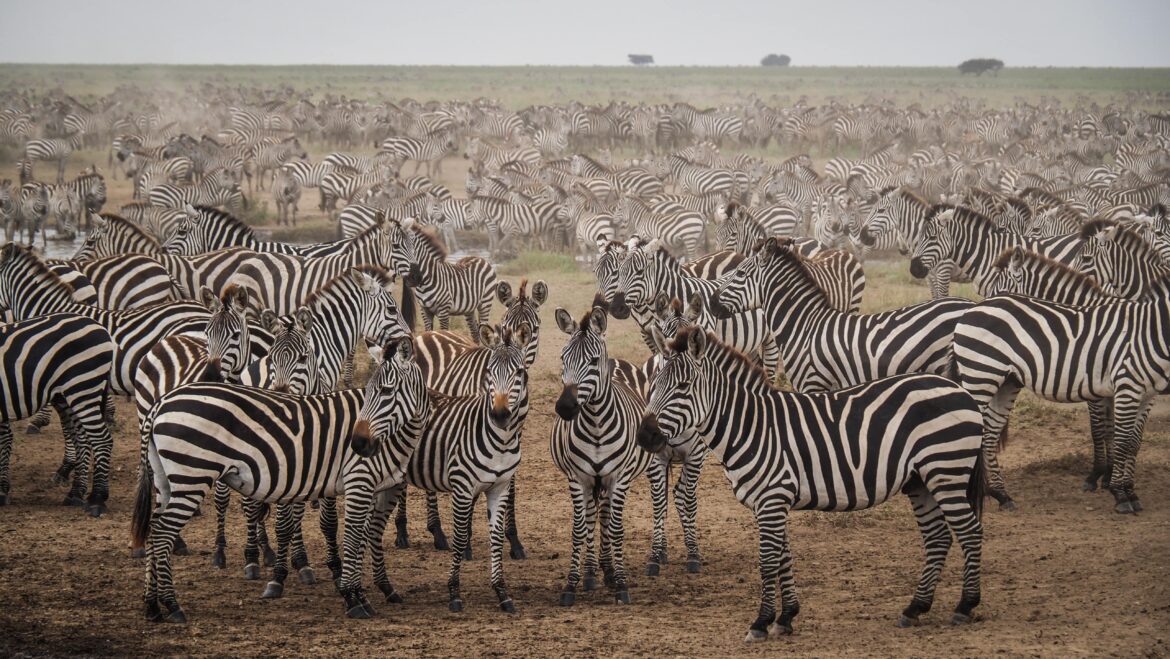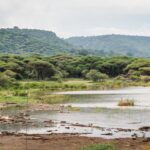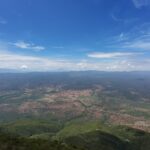The Serengeti is one of Africa’s most iconic ecosystems, stretching across Tanzania and into Kenya. The name Serengeti comes from the Maasai word “Siringet,” meaning “endless plains.” This vast savanna is home to the Great Migration, where millions of wildebeest, zebras, and gazelles move across the land in search of fresh grazing, followed closely by predators like lions, cheetahs, and hyenas.
For centuries, the Maasai people, one of East Africa’s most famous indigenous tribes, have lived in and around the Serengeti. They are semi-nomadic pastoralists known for their colourful shúkàs (robes), intricate beadwork, and deep connection to cattle which they consider sacred.
The Maasai arrived in the region around the 17th and 18th centuries, migrating south from the Nile Valley. They thrived in the Serengeti due to their mastery of cattle herding, a practice central to their culture. To the Maasai, cattle are not just livestock – they are a source of wealth, social status, and spiritual significance.
For a long time, the Maasai coexisted with wildlife, practising a sustainable lifestyle that allowed animals to roam freely. Unlike some other tribes, they traditionally avoided hunting wild animals, relying instead on their cattle for food.



The Serengeti National Park was officially established in 1951 to protect its incredible wildlife, but this also led to challenges for the Maasai. Many were forced to relocate when the park boundaries were drawn, particularly from the Ngorongoro Conservation Area, where they had lived and grazed cattle for generations.
While they were excluded from Serengeti National Park itself, the Maasai were later allowed to live and graze their cattle in certain areas, such as Ngorongoro, which became a multi-use conservation zone. This led to ongoing discussions about land rights and conservation.
Today, the Serengeti remains one of the world’s greatest wildlife destinations.
How to get there?
The Serengeti is located in northern Tanzania, about 325 km from Arusha, the main gateway for safaris. You can reach the park by air or road, depending on your budget and preference.
By Air
If you want to save time, flying is the best option. Several small airlines operate flights to airstrips within the park.
Domestic flights to Serengeti depart from: Arusha, Kilimanjaro, Dar es Salaam, or Zanzibar and arrive at: Seronera, Kogatende, Grumeti, or other Serengeti airstrips. Cost: $200–$500 one way (varies by season and route)
By Road with Organized Safari
Driving to the Serengeti allows you to enjoy the stunning landscapes along the way, but it takes longer. Most visitors travel by 4×4 safari vehicles with a guide, either on a private or group tour.
Book a private or group safari tour from Arusha or other nearby locations for minimal hassle. I booked mine with Travel Africa Safari Agency as a part of a 6-day safari that included Tarangire, Ngorongoro, Serengeti, and Lake Manyara. Although some organizational aspects could be improved, it was a good quality-to-price ratio. They offer so-called joining safari, which is a great way to save money and meet new people.
The drive from Arusha to Serengeti takes about 5-7 hours. It’s the best option for travellers who want a full safari experience and don’t mind long drives.



The best time to visit
The Serengeti is a year-round destination, but the best time to visit depends on what you want to see, especially the Great Migration and wildlife viewing conditions.
Best Overall Time: Dry Season (June – October)
This is the prime safari season when wildlife is easiest to spot as animals gather around water sources. The weather is dry, and roads are in good condition. Cool mornings, warm afternoons, little to no rain.
Great Migration: July to October is when wildebeest cross the Mara River into Kenya’s Masai Mara, an epic sight.
Crowds: High – it’s peak season, so book early.
Best for the Great Migration: December – July
December – March: Calving season in the southern Serengeti (Ndutu area) – thousands of wildebeest give birth, attracting predators.
April – May: Herds start moving north; lush landscapes but occasional heavy rains.
June – July: Dramatic Grumeti River crossings as wildebeest head north.
Best for Fewer Crowds & Green Scenery: Wet Season (November – May)
The landscape is lush, fewer tourists, and fantastic birdwatching. Wildlife viewing is still good, but animals spread out more. Short rains (Nov-Dec) and long rains (March-May), but safari lodges stay open.
Great Migration: Calving season (Feb – March) is ideal for baby animals and predator action.

When to Avoid?
March-May: Heavy rains can make some roads muddy and harder to navigate, but the scenery is breathtaking.
My experience
I spent in Serengeti 48 hours at the end of January and damn, what an experience it was!
Day 1: The way to Serengeti
The day started with a breakfast at Ngedere Lodge in Mto Wa Mbu. We arrived there the day before after doing a game drive in Tarangire National Park. The lodge is a kind of base for the safari operator that I used. Different jeeps were coming and leaving, taking people to their destinations. Even though I booked a camping safari, I got a private room in the lodge which was really nice and there was hot water under the shower. Dinner and breakfast were delicious and there was even a short dancing and acrobatics show performed by a local group of enthusiasts.
After breakfast, we were introduced to our driver – Mayunga. Besides him, there were 6 of us in a Toyota Land Cruiser which is a typical safari car in Tanzania.

After over 1 hour drive, we reached the entrance gate to Ngorongoro Conservation Area. While Mayunga was getting the permit, we had time to use the restrooms and have a look at the baboons hanging around the parking. Then, we stopped at the Ngorongoro Crater Viewpoint and it was simply breathtaking! Such an impressive vast caldera, full of green colour contrasting with blue sky. Thanks to binoculars we could spot some bigger animals down there. We had a game drive in Ngorongoro Crater planned after visiting Serengeti, so it was just a first taste of it, so far from the viewpoint of the crater rim.
While we were taking pictures, Mayunga noticed that we had a flat tyre and he had to change it. I was thinking that it wasn’t a good sign that we had first problems with a vehicle after such a short drive but luckily it was the first and last time.



Once he fixed the wheel, we continued through the land of Maasai, with their villages and bomas visible in the distance. We also noticed the first animals: wildebeest and zebras. Soon, we reached the entrance sign of Serengeti National Park so we stopped for a picture. Maasai people and their houses disappeared from the landscape as today they cannot live inside the park. We followed a wide dirt road, and soon we encountered one of the best experiences during the whole trip – the Great Migration. Thousands of zebras and wildebeests were on the road and around it. We also saw some elephants and buffaloes.
Unfortunately, it started raining so we had to close the roof of our Land Cruiser but still, it was an epic ride. Once we were getting closer to our camp, Mayunga got some info on the radio and quickly turned around. We could only suspect that there is some animal that he wants to show us and we were not wrong. A lion was sleeping on the branch of a huge tree, in the middle of the savannah. The view like straight from the National Geographic documentary film. I was so looking forward to the next day!

We arrived at the campsite. The tents were more than fine so I put my stuff inside and went to the eating area to enjoy dinner and conversation with the rest of my group. Suddenly, someone screamed: LIONS! And indeed, a group of about 17 lions were passing by near the campsite. Imagine that! On the next day, someone noticed a paw print in the sand very close to the tents. They were around the whole night!
I imagined that the camps were somehow fenced and there were some armed guards, but it was just an open area in the middle of the savannah! For me, it was a really cool experience, although some people were afraid to go pee in the middle of the night 🙂
Day 2: Full-day game drive in Serengeti
We started the game drive without unnecessary delays which I liked a lot. Soon after leaving the camp, we saw some giraffes and elephants. After that, we headed towards the “hippo pool” and as the name suggests, there were plenty of them. They are quite bad with hygiene so prepare yourself for intense and not necessarily pleasant smells. The weather was pretty crappy as it was rainy and quite cold!
Then, we started heading towards the border with Kenya and it was quite a long drive without any significant wildlife but scenic nevertheless. We stopped for a bush lunch on the hood of our Land Cruiser.
We made a few rounds around that area but didn’t spot anything significant so we started heading back. Finally, we encountered some more elephants and hippos and at the end of the day, lions. One of them, a female, was walking in the grass and Mayunga took a right turn to meet it on the parallel road. Unfortunately, he drove a bit too close so the car scared the animal off, but we were able to see as it climbed the tree and got itself comfortable on a branch.



Then, we saw some more lions, including males with impressive hair but we couldn’t get any closer by car as leaving the main roads is not allowed. The lions were quite lazy, just lying in the grass! Anyway, it was an exciting end of the day!
During the dinner, someone forgot to close the door to the eating area and a hyena came inside but then quickly escaped when one of the drivers screamed to scare it off. We could only see its eyes in the nearby bush, reflecting the light of the flashlights.
Day 3: Great Migration and leaving the park
The morning was pretty chilly again, and the plan for the day was a half-day game drive in Serengeti and then drive to the campsite in Ngorongoro. The flat plains are broken in several places by isolated and much-eroded granite “islands” called kopjes, and we spent some time going around them looking for lions, but unfortunately, we weren’t lucky.
However, shortly after, all of a sudden we encountered again the Great Migration. Hundreds of zebras and wildebeests were followed by predators resting just a few meters away in the grass. Breathtaking. I just couldn’t stop taking pictures and absorbing what I could see. Amazing spectacle of nature. For me, it was the best part of the safari. Zebras or wildebeests are not in the Big Five, but their number and presence all around were just mindblowing.



Then, we continued the drive, and we found some cheetahs. They were lying under the tree, chilling in a shadow. Unfortunately, other cars were blocking the access, so I couldn’t take a decent picture, and it seemed that Mayunga was a bit in a hurry to head to the exit from the park as he didn’t want to wait too long to get a better angle.
There was one more cheetah out there in the plains. It looked majestic. What a smooth and dynamic body!
Then, we started heading towards the exit of Serengeti. We saw one more lion under the tree, consuming the leg of a zebra. That view couldn’t get any more authentic.
We stopped for lunch at the gate and it was time to say goodbye to magical Serengeti. I truly hope that one day I will come back to this place.
Nearby places worth visiting
Ngorongoro Conservation Area
The Ngorongoro Conservation Area is a unique protected region in northern Tanzania, known for its diverse wildlife, stunning landscapes, and rich history. It is home to the Ngorongoro Crater, the world’s largest inactive, intact volcanic caldera, which supports many animals, including the Big Five: lions, elephants, buffaloes, leopards, and rhinos.
It’s about 2 hours drive from Naabi Hill Gate to Ngorongoro Crater Viewpoint. You will more information about this place in a separate post HERE.

Tarangire National Park
It is home to one of the largest elephant populations in Tanzania. You may also spot lions, leopards, cheetahs, giraffes, zebras, buffalo, wildebeest, and over 500 bird species.
Tarangire River is the park’s lifeline and attracts wildlife year-round. In the dry season (June–October), animals from surrounding areas migrate here for water.
The park’s landscape is known for its iconic baobab trees, also known as the “Tree of Life.” Other than that, you will experience rolling savannas, wetlands, and acacia woodlands.
It’s about 4-5 hours drive from Naabi Hill Gate to Tarangire National Park. You will more information about this place in a separate post HERE.

Lake Manyara National Park
Lake Manyara is a shallow, alkaline lake. It covers approximately 470 square kilometres and is part of Lake Manyara National Park, a UNESCO-designated biosphere reserve. The lake is known for its rich biodiversity, including large populations of flamingos, over 400 bird species, and a variety of wildlife such as elephants, hippos, giraffes, and the famous tree-climbing lions.
It’s about a 3-hour drive from Naabi Hill Gate to Lake Manuara National Park. You will more information about this place in a separate post HERE.




